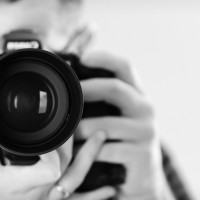by Rui Ribeiro
Damselflies are always interesting to photograph due to their beauty. Each species has such wonderful colors. Some are very docile; sometimes it even seems that they are communicating with us, reminding us of aliens. Yet others are too restless and sometimes difficult to photograph.

Sony A55 . Tamron 90mm f/2.8 . 1/400s . f/2.8 . ISO 100
This photo of a damselfly, Chalcolestes viridis (a species formerly known as Lestes viridis), was taken on a riverbank next to my house where I used to go trout fishing. Since I have not gone fishing for a few years, and because these days my fishing rod has turned into something else (a camera), I remembered that the times I was fishing in this area, damselflies were always around. I have always been fascinated by their beautiful colors, especially when they landed on the tip of my fishing pole and allowed me a few brief seconds to study them so closely. And I just love macro photography, so on this day I decided to return to the river to photograph them.
"That's when I saw one on the tip of a branch — how I just loved watching that backlit silhouette catching the last rays of the sun."
When I arrived it was late, around 6:00 p.m. in early November, and the sun was starting to set. I decided to start photographing some damselflies, taking advantage of what little light was left for me. Since I only like to use natural light in my macro shots, and I did not have a tripod with me, combined with the fact that it was windy that evening, I found that I needed to use a very high ISO. The sun was already near the horizon, so I decided to look for a damselfly that was backlit. That's when I saw one on the tip of a branch — how I just loved watching that backlit silhouette catching the last rays of the sun.
"It felt like it had intentionally stopped right there, waited to be photographed, and then flew away with all the glamor of a true movie star."
I adjusted the aperture to f/2.8 to form the bokeh, set the shutter speed 1/400 second due to the wind, used manual focus and created a composition following the rule of thirds. In macro photography, I try to always use manual focus, holding my breath each time I press the shutter button to prevent camera shake, until I have the desired details properly focused. In this particular case I managed to shoot about five photos before the damselfly took off to other places. It felt like it had intentionally stopped right there, waited to be photographed, and then flew away with all the glamor of a true movie star.
The image was processed in Adobe Camera Raw, Lightroom 5.1 and Photoshop CS6.
1) I adjusted the RAW file in Camera Raw and Lightroom 5.1 to give it a bit more brightness and contrast and to slightly increase the shadows.
2) In Lightroom, I converted the image to black and white in the HSL/Color/B&W panel by selecting B&W and adjusting the tones by moving some of the color sliders.
3) I then made a slight crop.
4) I exported the photo to Photoshop CS6 in PSD format and again adjusted the brightness and contrast in the shadows by applying a Levels adjustment layer. To sharpen the photo, I selected Filter > Sharpen > Smart Sharpen and adjusted the settings.
5) I reopened the image in Lightroom to fine-tune the black and white conversion in the B&W tab, and lastly I used the Adjustment Brush to remove some noise that had appeared in the background due to the crop.
1) One of the tips I usually give is that in macro photography, you sometimes have to be very patient and wait for the right moment. It is possible that you will spend several hours waiting for this moment, simply to make one single photo. But after seeing the final result, you can often expect a reward.
2) Insects behave just as humans do when it comes to running fast, getting tired and needing to stop for a rest. Insects and reptiles at first glance seem very restless, but they always end up stopping to rest, if only for just a brief second. That is the time you must be ready to shoot.
3) Always use manual focus to focus precisely so you can capture the intricate details, which for me is usually the eyes. At the beginning, manual focus will seem difficult due to the movement of the camera and the fast, constant motion of your tiny subjects, especially insects, so take the time to practice.
I was born in 1974 in the beautiful city of Viseu, Portugal. I have been passionate about photography since childhood. I remember when I was young how excited I was looking through the pictures in my grandfather's National Geographic books. I started taking pictures in 2011 when I bought my first reflex camera. I was always self-taught in almost everything I did, and photography was no exception.
Before I started practicing and shooting, I spent one year reading everything that existed on photographic techniques. I saw thousands of photos and tried to understand how the photographers had managed to attain those results. When I visualize a photograph, I cannot rest until I achieve my desired result, and even for this I have to spend hours to get there.
I love all genres in photography, particularly macro, action, documentary, landscape and street. I live, breathe and love photography.










